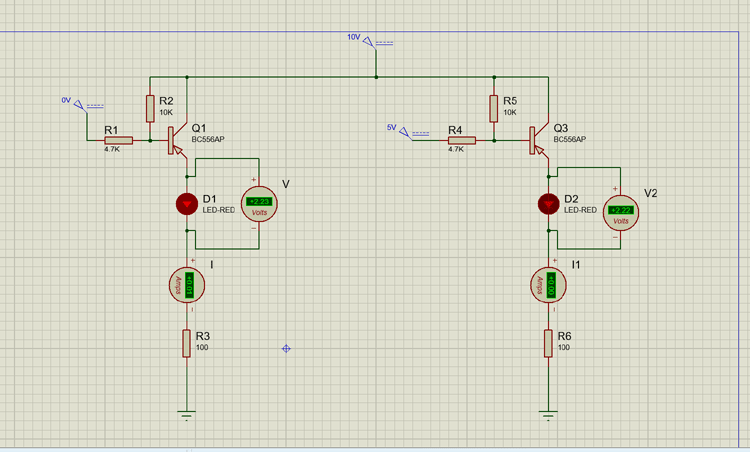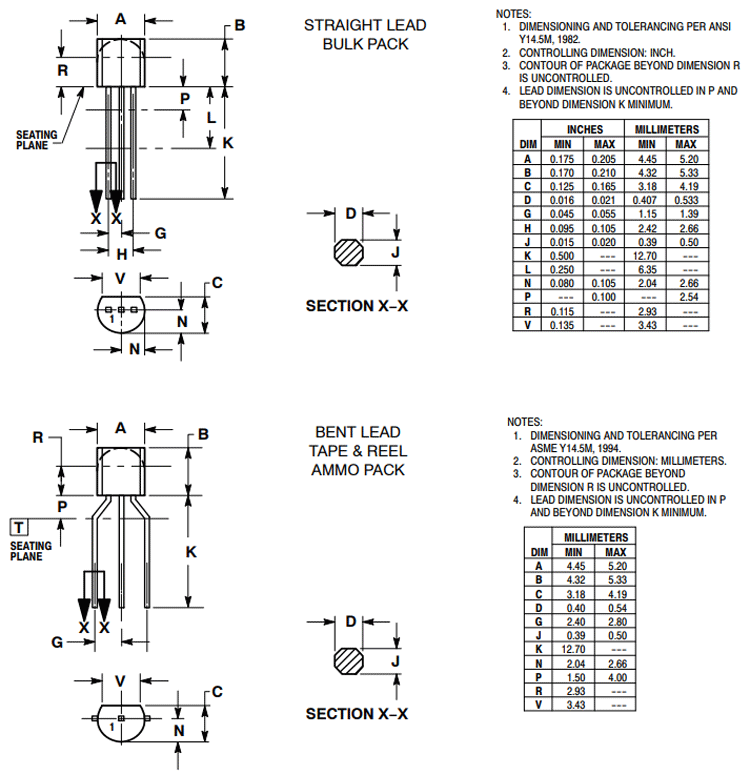BC556 PNP Transistor
BC556 Pinout Configuration
|
Pin Number |
Pin Name |
Description |
|
1 |
Collector |
Electrons Emitted from Emitter Collected by the Collector |
|
2 |
Base |
Controls the biasing of the transistor |
|
3 |
Emitter |
Electrons emitted from the emitter into the first PN junction |
Basic Overview and Features
• Switching and Amplifier
• High−Voltage: BC556, VCEO = -65 V
• Low−Noise: BC559, BC560
• Complement to BC546, BC547, BC548, BC549
• These are Pb−Free Devices
• PNP transistor in a TO-92; SOT54 plastic package.
• Low current (max. 100 mA)
Note: The above specs can vary depending upon the manufacturers of the device. You can check out the BC556 Datasheet, given at the bottom of the page.
BC556 Equivalent Transistor
BC558, S8550, A1015, BC557, 2N3906, 2N4403, BC857, 2N2907, 2N5401
Basic Working of a PNP Transistor
A PNP transistor is made up of a doped N-Type material that is sanduzied in between two P-Type materials. In a PNP transistor holes are the majority charge carrier that means the holes are emitted by the collector and collected by the emitter, the main difference between the NPN and PNP transistor is the flow of electrons runs from collector to emitter but in a PNP transistor the electrons run from emitter to collector, as a result, a PNP transistor turns on when there is a low or 0V on the base of the transistor. Where an NPN transistor is on when a positive or high signal is applied.
General Description of BC556 Transistor
The BC556 is a PNP Transistor, hence we need to provide zero volts to the base of the transistor to turn it on. This transistor comes with many different versions, if you are using this transistor as an amplifier make sure you check the gain of the transistor from the datasheet that can be found down below, because of different versions the gain value differs which can completely ruin your calculations. The maximum collector current of this transistor is rated at -100mA with a peak current of -200mA, this transistor has an emitter-base voltage of -5V. This transistor has a collector-emitter voltage of -65V and a collector base voltage of -80V. This transistor can operate with 150*C.
When this transistor is in biased condition, then it can allow a maximum current of 100mA across CE(Collector-Emitter) Junction, this state of the transistor is called the saturation state, and driving a load that consumes more current than 100mA may damage the device in this condition. As you already may know a transistor is a current-controlled device so when the base current is removed the transistor becomes fully off, in this stage the transistor is working in its Cut-off Region and the Base Emitter voltage could be around 660 mV.
BC556 Transistor has a gain of 125 to 450 which determines the amplification capacity of the transistor, the peak current that can be flown through this transistor is 200maA, which combines with the gain value makes this transistor a perfect choice for a preamplifier for audio amplifier.
How to use BC556 Transistor
Transistors are current-controlled devices so to turn them on/off a little current is needed. For the BC556 Transistor, this current is less than 2mA, as BC556 is a PNP transistor that means it will be on when the base is connected to the ground, and it will be off when a positive voltage is applied to the base of the transistor.
The simulated circuit below shows how this transistor behaves when the base of the basic circuit is connected to the ground and when it's connected to 5V of the power supply.

When we turn on the transistor by connecting the base to the ground(in our case we have used a 0V probe in protius), the transistor will remain on unless the voltage at the base of the transistor reaches more than the base turn off voltage, for this transistor, it is somewhere in between 0.7 -0.9V. The base of the transistor cannot be left floating otherwise there could be false triggering, which may lead to issues in the circuit. To resolve the issue we need to add pullup resistors as shown in the example a 10K resistor is used to pull up the base of the transistor to VCC.
Applications
- Build simple audio circuits
- General-purpose amplifier
- Driver Modules like Relay Driver, LED driver, etc..
- Amplifier modules like Audio amplifiers, signal Amplifiers, etc..
- Darlington pair
2D Model and Dimensions
If you are designing a PCB or Perf board with this component then the following picture from the Datasheet will be useful to know its package type and dimensions.












